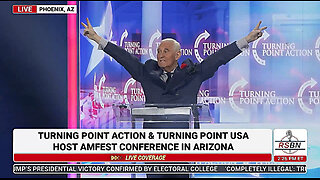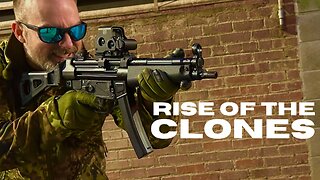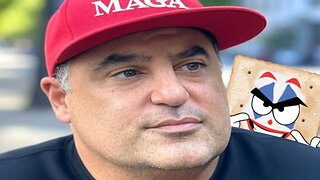Premium Only Content

ENOLA GAY, The b-29 That Dropped The Atomic Bomb | Documentary.
B-29 ENOLA GAY, The Aircraft That Dropped The Atomic Bomb | Documentary
Enola Gay. Boeing B-29 Superfortress | The Bomber that dropped the atomic bomb and changed the world. FULL 1h 30" Documentary.
The Enola Gay is a Boeing B-29 Superfortress bomber, named after Enola Gay Tibbets, the mother of the pilot, Colonel Paul Tibbets. On 6 August 1945, piloted by Tibbets and Robert A. Lewis during the final stages of World War II, it became the first aircraft to drop an atomic bomb in warfare. The bomb, code-named "Little Boy", was targeted at the city of Hiroshima, Japan, and caused the destruction of about three quarters of the city. Enola Gay participated in the second nuclear attack as the weather reconnaissance aircraft for the primary target of Kokura. Clouds and drifting smoke resulted in a secondary target, Nagasaki, being bombed instead.
After the war, the Enola Gay returned to the United States, where it was operated from Roswell Army Air Field, New Mexico. In May 1946, it was flown to Kwajalein for the Operation Crossroads nuclear tests in the Pacific, but was not chosen to make the test drop at Bikini Atoll. Later that year it was transferred to the Smithsonian Institution, and spent many years parked at air bases exposed to the weather and souvenir hunters, before being disassembled and transported to the Smithsonian's storage facility in Maryland, in 1961.
On 5 August 1945, during preparation for the first atomic mission, Tibbets assumed command of the aircraft and named it after his mother, Enola Gay Tibbets, who, in turn, had been named for the heroine of a novel.
In the early morning hours, just prior to the 6 August mission, Tibbets had a young Army Air Forces maintenance man, Private Nelson Miller, paint the name just under the pilot's window. Regularly-assigned aircraft commander Robert Lewis was unhappy to be displaced by Tibbets for this important mission, and became furious when he arrived at the aircraft on the morning of 6 August to see it painted with the now-famous nose art.
Hiroshima was the primary target of the first nuclear bombing mission on 6 August, with Kokura and Nagasaki as alternative targets. Enola Gay, piloted by Tibbets, took off from North Field, in the Northern Mariana Islands, about six hours' flight time from Japan, accompanied by two other B-29s.
Bombardier Thomas Ferebee with the Norden Bombsight on Tinian after the dropping of Little Boy
Enola Gay's crew on 6 August 1945, consisted of 12 men. The crew was:
Colonel Paul W. Tibbets Jr. – pilot and aircraft commander
Captain Robert A. Lewis – co-pilot; Enola Gay's regularly assigned aircraft commander*
Major Thomas Ferebee – bombardier
Captain Theodore "Dutch" Van Kirk – navigator
Captain William S. "Deak" Parsons, USN – weaponeer and mission commander.
First Lieutenant Jacob Beser – radar countermeasures (also the only man to fly on both of the nuclear bombing aircraft.[35])
Second Lieutenant Morris R. Jeppson – assistant weaponeer
Staff Sergeant Robert "Bob" Caron – tail gunner*
Staff Sergeant Wyatt E. Duzenbury – flight engineer*
Sergeant Joe S. Stiborik – radar operator*
Sergeant Robert H. Shumard – assistant flight engineer*
Private First Class Richard H. Nelson – VHF radio operator*
Asterisks denote regular crewmen of the Enola Gay.
General characteristics
Crew: 11 (Pilot, Co-pilot, Bombardier, Flight Engineer, Navigator, Radio Operator, Radar Observer, Right Gunner, Left Gunner, Central Fire Control, Tail Gunner)
Length: 99 ft 0 in (30.18 m)
Wingspan: 141 ft 3 in (43.05 m)
Height: 27 ft 9 in (8.46 m)
Wing area: 1,736 sq ft (161.3 m2)
Aspect ratio: 11.5
Airfoil: root: Boeing 117 (22%); tip: Boeing 117 (9%)
Zero-lift drag coefficient: 0.0241
Frontal area: 41.16 sq ft (3.824 m2)
Empty weight: 74,500 lb (33,793 kg)
Gross weight: 120,000 lb (54,431 kg)
Max takeoff weight: 133,500 lb (60,555 kg)
135,000 lb (61,000 kg) combat overload
Powerplant: 4 × Wright R-3350-23 Duplex-Cyclone 18-cylinder air-cooled turbosupercharged radial piston engines, 2,200 hp (1,600 kW) each
Propellers: 4-bladed constant-speed fully-feathering propellers, 16 ft 7 in (5.05 m) diameter
Performance
Maximum speed: 357 mph (575 km/h, 310 kn)
Cruise speed: 220 mph (350 km/h, 190 kn)
Stall speed: 105 mph (169 km/h, 91 kn)
Range: 3,250 mi (5,230 km, 2,820 nmi)
Ferry range: 5,600 mi (9,000 km, 4,900 nmi)
Service ceiling: 31,850 ft (9,710 m)
Rate of climb: 900 ft/min (4.6 m/s)
Lift-to-drag: 16.8
Wing loading: 69.12 lb/sq ft (337.5 kg/m2)
-
 13:21
13:21
Joseph Wouk's Channel
13 days agoVivek Ramaswamy Keynote on DOGE @ American Legislation Council (Dec. 5, 2024)
1.97K -
 14:36
14:36
The StoneZONE with Roger Stone
1 day agoRoger Stone Delivers Riveting Speech at Turning Point’s AMFEST 2024 | FULL SPEECH
72.4K22 -
 18:59
18:59
Fit'n Fire
11 hours ago $5.13 earnedZenith ZF5 The Best MP5 Clone available
35.5K1 -
 58:34
58:34
Rethinking the Dollar
20 hours agoTrump Faces 'Big Mess' Ahead | RTD News Update
31.2K5 -
 5:35
5:35
Dermatologist Dr. Dustin Portela
20 hours ago $1.63 earnedUnboxing Neutrogena PR Box: Skincare Products and Surprises!
24.5K3 -
 11:20
11:20
China Uncensored
20 hours agoCan the US Exploit a Rift Between China and Russia?
54.2K16 -
 2:08:48
2:08:48
TheSaltyCracker
15 hours agoLefty Grifters Go MAGA ReeEEeE Stream 12-22-24
251K680 -
 1:15:40
1:15:40
Man in America
18 hours agoThe DISTURBING Truth: How Seed Oils, the Vatican, and Procter & Gamble Are Connected w/ Dan Lyons
147K131 -
 6:46:07
6:46:07
Rance's Gaming Corner
20 hours agoTime for some RUMBLE FPS!! Get in here.. w/Fragniac
173K4 -
 1:30:48
1:30:48
Josh Pate's College Football Show
19 hours ago $11.31 earnedCFP Reaction Special | Early Quarterfinal Thoughts | Transfer Portal Intel | Fixing The Playoff
105K1